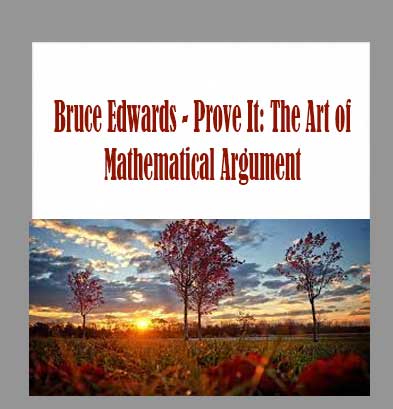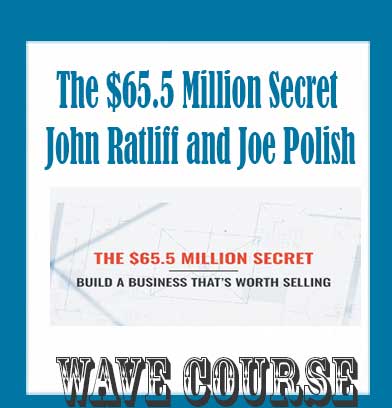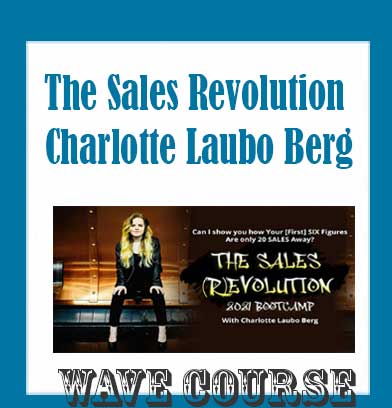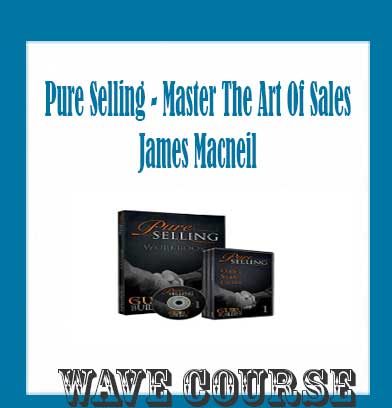
Description
Bruce Edwards – Prove It: The Art of Mathematical Argument download, Bruce Edwards – Prove It: The Art of Mathematical Argument review, Bruce Edwards – Prove It: The Art of Mathematical Argument free
Bruce Edwards – Prove It: The Art of Mathematical Argument
Prove It: The Art of Mathematical Argument
Experience the thrilling pursuit of a mathematical proof in this course suitable for everyone from high school students to math lovers.
LESSON
Trailer
01:What Are Proofs, and How Do I Do Them?
Start by proving that two odd numbers multiplied together always give an odd number. Next, look ahead at some of the intriguing proofs you will encounter in the course. Then explore the characteristics of a proof and tips for improving your skill at proving mathematical theorems.
32 min
02:The Root of Proof-A Brief Look at Geometry
The model for modern mathematical thinking was forged 2,300 years ago in Euclid’s Elements. Prove three of Euclid’s theorems and investigate his famous fifth postulate dealing with parallel lines. Also, learn how proofs are important in Professor Edwards’s own research.
31 min
03:The Building Blocks-Introduction to Logic
Logic is the foundation of mathematical proofs. In the first of three lectures on logic, study the connectors “and” and “or.” When used in combination in mathematical statements, these simple terms can create interesting complexity. See how truth tables are very useful for determining when such statements are true or false.
30 min
04:More Blocks-Negations and Implications
Continue your study of logic by looking at negations of statements and the logical operation called implication, which is used in most mathematical theorems. Professor Edwards opens the lecture with a fascinating example of the implication of a false hypothesis that appears to pose a logical puzzle.
30 min
05:Existence and Uniqueness-Quantifiers
In the final lecture on logic, explore the quantifiers “for all” and “there exists,” learning how these operations are negated. Quantifiers play a large role in calculus-for example, when defining the concept of a sequence, which you study in greater detail in upcoming lectures.
30 min
06:The Simplest Road-Direct Proofs
Begin a series of lectures on different proof techniques by looking at direct proofs, which make straightforward use of a hypothesis to arrive at a conclusion. Try several examples, including proofs involving division and inequalities. Then learn tricks that mathematicians use to make proofs easier than they look.
31 min
07:Let’s Go Backward-Proofs by Contradiction
Probe the power of one of the most popular techniques for proving theorems-proof by contradiction. Begin by constructing a truth table for the contrapositive. Then work up to Euclid’s famous proof that answers the question: Can the square root of 2 be expressed as a fraction?
31 min
08:Let’s Go Both Ways-If-and-Only-If Proofs
Start with the simple case of an isosceles triangle, defined as having two equal sides or two equal angles. Discover that equal sides and equal angles apply to all isosceles triangles and are an example of an “if-and-only-if” theorem, which occurs throughout mathematics.
31 min
09:The Language of Mathematics-Set Theory
Explore elementary set theory, learning the concepts and notation that allow manipulation of sets, their unions, their intersections, and their complements. Then try your hand at proving that two sets are equal, which involves showing that each is a subset of the other.
30 min
10:Bigger and Bigger Sets-Infinite Sets
Tackle infinite sets, which pose fascinating paradoxes. For example, the set of integers is a subset of the set of rational numbers, and yet there is a one-to-one correspondence between them. Explore other properties of infinite sets, proving that the real numbers between 0 and 1 are uncountable.
32 min
11:Mathematical Induction
In the first of three lectures on mathematical induction, try out this powerful tool for proving theorems about the positive integers. See how an inductive proof is like knocking over a row of dominos: Once the base case pushes over a second case, then by induction all cases fall.
31 min
12:Deeper and Deeper-More Induction
What does the decimal 0.99999… forever equal? Is it less than 1? Or does it equal 1? Apply mathematical induction to geometric series to find the solution. Also use induction to find the formulas for other series, including factorials, which are denoted by an integer followed by the “!” sign.
31 min
13:Strong Induction and the Fibonacci Numbers
Use a technique called strong induction to prove an elementary theorem about prime numbers. Next, apply strong induction to the famous Fibonacci sequence, verifying the Binet formula, which can specify any number in the sequence. Test the formula by finding the 21-digit-long 100th Fibonacci number.
30 min
14:I Exist Therefore I Am-Existence Proofs
Analyze existence proofs, which show that a mathematical object must exist, even if the actual object remains unknown. Close with an elegant and subtle argument proving that there exists an irrational number raised to an irrational power, and the result is a rational number.
31 min
15:I Am One of a Kind-Uniqueness Proofs
How do you prove that a given mathematical result is unique? Assume that more than one solution exists and then see if there is a contradiction. Use this technique to prove several theorems, including the important division algorithm from arithmetic.
31 min
16:Let Me Count the Ways-Enumeration Proofs
The famous Four Color theorem, dealing with the minimum number of colors needed to distinguish adjacent regions on a map with different colors, was finally proved by a brute force technique called enumeration of cases. Learn how this approach works and why mathematicians dislike it-although they often rely on it.
31 min
17:Not True! Counterexamples and Paradoxes
You’ve studied proofs. How about disproofs? How do you show that a conjecture is false? Experience the fun of finding counterexamples. Then explore some famous paradoxes in mathematics, including Bertrand Russell’s barber paradox, which shook the foundations of set theory.
30 min
18:When 1 = 2-False Proofs
Strengthen your appreciation for good proofs by looking at bad proofs, including common errors that students make such as dividing by 0 and circular reasoning. Then survey the history of attempts to prove some renowned conjectures from geometry and number theory.
31 min
19:A Picture Says It All-Visual Proofs
Before he became the 20th U. S. president, James A. Garfield published an original proof of the Pythagorean theorem that relied on a visual argument. See how pictures play an important role in understanding why a particular mathematical statement may be true. But is a visual proof really a proof?
32 min
20:The Queen of Mathematics-Number Theory
The great mathematician Carl Friedrich Gauss once said that if mathematics is the queen of the sciences, then number theory is the queen of mathematics. Embark on the study of this fascinating discipline by proving theorems about prime numbers.
29 min
21:Primal Studies-More Number Theory
Dig deeper into prime numbers and number theory by proving a conjecture that asserts that there are arbitrarily large gaps between successive prime numbers. Then turn to some celebrated conjectures in number theory, which are easy to state but which have withstood all attempts to prove them.
31 min
22:Fun with Triangular and Square Numbers
Use different proof techniques to explore square and triangular numbers. Square numbers are numbers such as 1, 4, 9, and 16 that are the squares of integers. Triangular numbers represent the total dots needed to form an equilateral triangle, such as 1, 3, 6, and 10.
30 min
23:Perfect Numbers and Mersenne Primes
Investigate the intriguing link between perfect numbers and Mersenne primes. A number is perfect if it equals the sum of all its divisors, excluding itself. Mersenne primes are prime numbers that are one less than a power of 2. Oddly, the known examples of both classes of numbers are 47.
31 min
24:Let’s Wrap It Up-The Number e
Prove some properties of the celebrated number e, the base of the natural logarithm, which plays a crucial role in precalculus and calculus. Close with a challenging proof testing whether e is rational or irrational-just as you did with the square root of 2 in Lecture 7.
32 min
DETAILS
Overview
Mathematical proof is the gold standard of knowledge. Once a mathematical statement has been proved with a rigorous argument, it counts as true throughout the universe and for all time. Imagine, then, the thrill of being able to prove something in mathematics. But you don’t have to imagine the exhilaration of constructing a proof-you can do it! Prove It: The Art of Mathematical Argument initiates you into this thrilling discipline in 24 lectures by Professor Bruce H. Edwards of the University of Florida. This course is suitable for everyone from high school students to the more math-savvy.
About
Bruce H. Edwards
I love mathematics and tried to communicate this passion to others, regardless of their mathematical backgrounds.
Dr. Bruce H. Edwards is Professor of Mathematics at the University of Florida. Professor Edwards received his B.S. in Mathematics from Stanford University and his Ph.D. in Mathematics from Dartmouth College. After his years at Stanford, he taught mathematics at a university near Bogota, Colombia, as a Peace Corps volunteer. Professor Edwards has won many teaching awards at the University of Florida, including Teacher of the Year in the College of Liberal Arts and Sciences, Liberal Arts and Sciences Student Council Teacher of the Year, and the University of Florida Honors Program Teacher of the Year. He was selected by the Office of Alumni Affairs to be the Distinguished Alumni Professor for 1991-1993. Professor Edwards has taught a variety of mathematics courses at the University of Florida, from first-year calculus to graduate-level classes in algebra and numerical analysis. He has been a frequent speaker at research conferences and meetings of the National Council of Teachers of Mathematics. He has also coauthored a wide range of mathematics textbooks with Professor Ron Larson. Their textbooks have been honored with various awards from the Text and Academic Authors Association.
REVIEWS
Johnbatchler1111
Miami fl
Great prof
For a university prof he is great better than most profs I’ve seen this course is handy for introduction to proofs compare to what I’m learning it from spivak calculus
Ran Blake
Thoughts on Bruce Edward’s Great new DVD
Bruce Edwards has done it again in his new great video course Prove It: The Art of Mathematical Argument. For serious readers, we owe thanks to William Dunham’s Journey through Genius published in 1990, but rarely has this material been available on DVD. Professor Edwards takes us on a journey where this complex subject is expressed so clearly, particularly after the second lesson. Throughout the course Professor Edwards introduces his own ideas in an important branch of logic. Initially a tad dry for my inpatient disposition, Edwards slowly reviews and logically covers the basic principles. There are only three lessons around the beginning of the third DVD where the material becomes complicated to follow.
One can see the pleasure and excitement Edwards puts into his lectures, particularly during lesson seven on contradiction proofs. His ideas on proofs should enlighten the followers of mathematics in any branch.
Reviewed by Ran Blake. Blake is a recordi
Frequently Asked Questions:
- Innovative Business Model:
- Embrace the reality of a genuine business! Our approach involves forming a group buy, where we collectively share the costs among members. Using these funds, we purchase sought-after courses from sale pages and make them accessible to individuals facing financial constraints. Despite potential reservations from the authors, our customers appreciate the affordability and accessibility we provide.
- The Legal Landscape: Yes and No:
- The legality of our operations falls into a gray area. While we lack explicit approval from the course authors for resale, there’s a technicality at play. When procuring the course, the author didn’t specify any restrictions on resale. This legal nuance presents both an opportunity for us and a boon for those seeking budget-friendly access.
- Quality Assurance: Unveiling the Real Deal:
- Delving into the heart of the matter – quality. Acquiring the course directly from the sale page ensures that all documents and materials are identical to those obtained through conventional means. However, our differentiator lies in going beyond personal study; we take an extra step by reselling. It’s important to note that we are not the official course providers, meaning certain premium services aren’t included in our package:
- No coaching calls or scheduled sessions with the author.
- No access to the author’s private Facebook group or web portal.
- No entry to the author’s exclusive membership forum.
- No direct email support from the author or their team.
We operate independently, aiming to bridge the affordability gap without the additional services offered by official course channels. Your understanding of our unique approach is greatly appreciated.
- Delving into the heart of the matter – quality. Acquiring the course directly from the sale page ensures that all documents and materials are identical to those obtained through conventional means. However, our differentiator lies in going beyond personal study; we take an extra step by reselling. It’s important to note that we are not the official course providers, meaning certain premium services aren’t included in our package:
Refund is acceptable:
- Firstly, item is not as explained
- Secondly, Item do not work the way it should.
- Thirdly, and most importantly, support extension can not be used.
Thank you for choosing us! We’re so happy that you feel comfortable enough with us to forward your business here.








Reviews
There are no reviews yet.